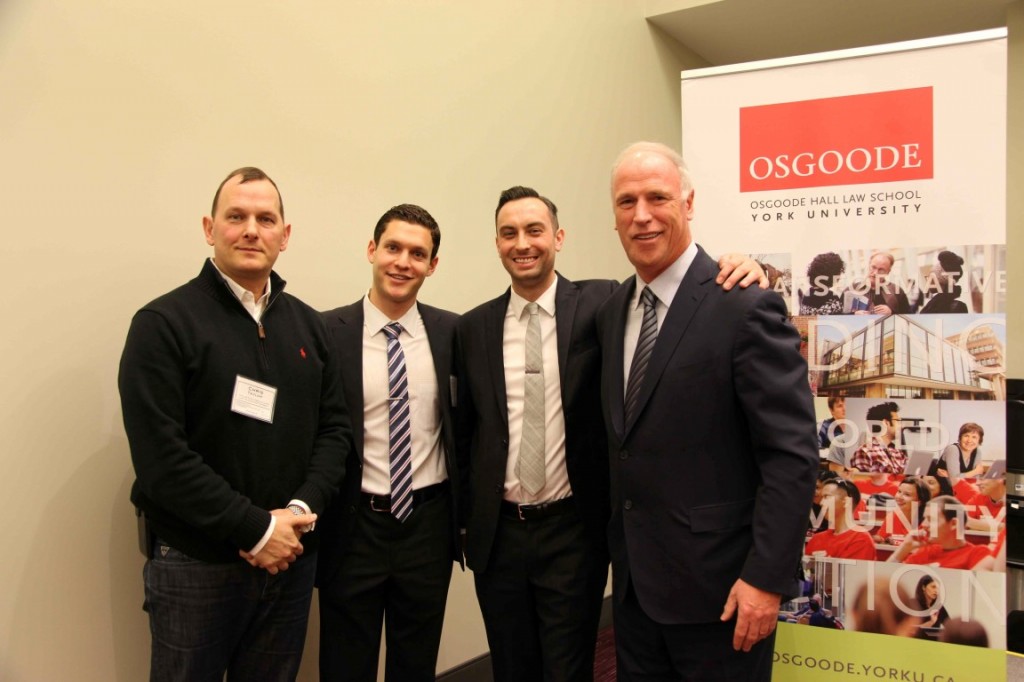
MANAGEMENT SPOKE ON THE TOPIC OF CELEBRITY REPRESENTATION
AT THE ESLA CONFERENCE.
PICTURED , LEFT TO RIGHT: TAYLOR, ESLA CO-PRESIDENTS
JONATHAN SHERMAN AND DAN MOWAT-ROSE, MEEHAN.
With television and movie producers increasingly turning to the Internet to reach audiences, and the music industry in a state of chaos as they lose hold of the proprietary value once held in their product, it is clear that major changes to the entertainment industry are underway. Significant shifts in the expectations of audiences, the makeup of that audience, and the availability of services, have meant that a fundamental rethinking of the value of entertainment is required. Within this context, entertainment lawyers are being forced to choose sides, holding on to the traditional values of the industry, or innovating to try and capture profitability within the changing landscape. Given that such substantial changes have already become engrained in our culture and expectations, I would argue that innovation has emerged as the only viable option.
At the 2014 Annual Osgoode Entertainment and Sports Law Association Conference, an interesting and well-run event held in early March, the growing divergence in the entertainment industry was on full display. While some speakers seemed to approach the changing marketplace with excitement and intrigue, others made clear they were perfectly comfortable in the confines of the status quo. In the morning session of the conference, Dave Hopkinson of Maple Leaf Sports and Entertainment accurately articulated the excitement in the sports world over the changing landscape. With greater access to games through online services, MLSE has begun focusing their efforts on a user-driven, customizable viewing experience, utilising new technologies and services available through the Internet. The United States is already years ahead of us on this model. This year, March Madness was streamed online for free through the NCAA.com website, on a customizable platform that allowed users to switch between games, check stats, and interact on social media. With such services entering the Canadian marketplace, the industry has little choice but to seek out the benefit of such changes.
The hesitance to take such a forward-thinking approach was clear during the conference’s afternoon session. Pamela Dinsmore of Rogers Media seemed to embody the attitude which has garnered her company’s negative reputation for years. Rogers is prepared to take only incremental steps into the online television market, and only after other companies have proven such changes successful. While Netflix continues to gnaw away at their customer base, Rogers seems prepared to hold fast. Unfortunately, given their monopolistic position in our marketplace, Rogers is one of only a few companies that could actually still garner profits with such a lacklustre approach. Fortunately, another speaker on the same panel, Raja Khanna of Blue Ant Media, proved that hesitancy does not completely permeate the industry. Mr. Khanna discussed the need to diversify profit-making activities in an online world where viewership does not necessarily translate into profits. Within the legal context, this will likely mean that lawyers provide increasingly consultative services for clients, helping them understand the new financial landscape as they adapt.
Where adaptation seems most needed, and, ironically, most fiercely resisted, is in the music industry. The dissemination of music over the Internet has virtually gutted the industry of its product’s value, leaving uncertainty and inconsistency in how the industry is viewed and treated. On the one hand, this shift has led to an even fiercer homogenization of pop music, since, with profits so uncertain, record labels have become even more hesitant to break from anything but the most standard model. It has also led industry figures to continue fighting a losing battle against piracy.
ESLA Conference speakers Steve Teixiera and Sundeep Chauhan sounded woefully out of touch as they paraded recent legal victories against The Pirate Bay and ISOhunt (sites which are both already back up and running). The approach of fighting Internet music dissemination through litigation not only alienates fans, but is also a lost cause. Even services like Spotify and Rdio, which seem to be making at least some advances in a changing market, have failed to capture profitability through music streaming. What may be needed is a renewed focus on the live act, or on the album as a piece of art worthy of purchase, in order to reinvigorate the industry. However, the feeling – from the ESLA Conference, at least – is that industry players continue to hold out hope on the old model, and are content to enjoy the short lived victories while reminiscing about the time Napster was taken offline (which, I should mention, was actually referred to as a relevant success story by one of the speakers).
Though the experiences for listeners and viewers continue to improve, within the entertainment industry it is clear that market changes face a mixed reception. The hesitation, in the television and music industries especially, is carving a void in both profitability and viability. Hopefully, some of the more innovative players will pick up the slack from the old traditionalists and help the industry keep pace with changing services and expectations. Fortunately for the entertained public, however, the technology is advancing at such a rate that we will continue enjoying an ever-improving entertainment experience, regardless of whether the providers are quick enough to figure out how to cash in.
